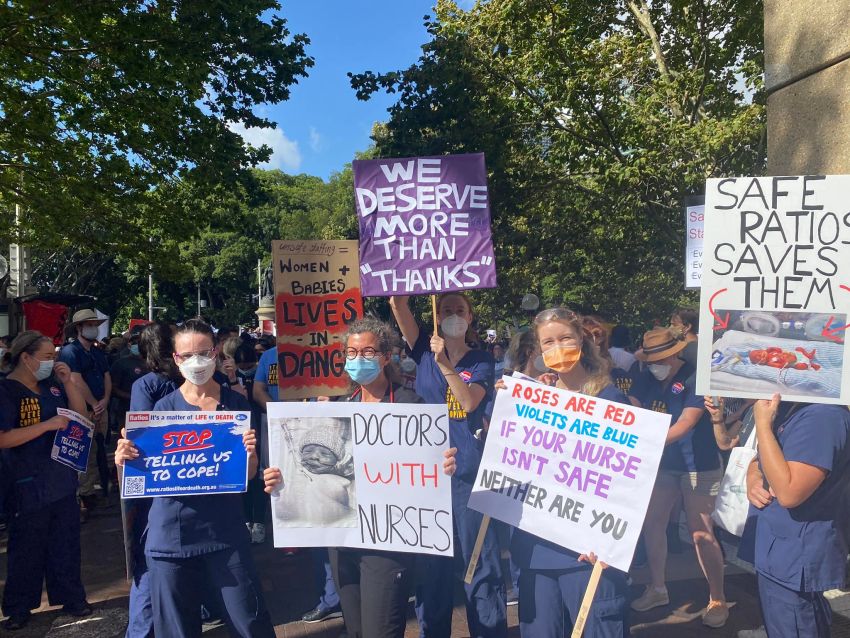
The Australian Bureau of Statistics (ABS) figures on June 1 once again confirm that inequality is rising.
During the 12 months to March, corporate profits before tax rose by more than 21%. This period includes the lockdowns in Sydney and Melbourne, triggered by the Delta outbreak, and the nationwide shadow lockdowns induced by the subsequent Omicron wave.
Overall, corporate profits’ share of national income has now reached a historic high of 31.1%. In contrast, workers’ share of national income has fallen to its lowest level on record — 45.1% — as real wages register a decline due to rising inflation.
These trends are not new.
There has been a steady decline in workers’ share of national income and a concurrent rise in the capitalists’ share since the late 1970s. The pandemic, and the policies enacted by state and federal governments, exacerbated them.
Furthermore, by digging further into the ABS figures, we can see that another important long-term trend was exacerbated by the pandemic, namely, growing inequality within the working class.
While the wages’ share of national income fell behind overall during the pandemic, not all workers’ wages moved in the same direction.
For example, compensation of employees in the private sector rose by 2.3% in the 12 months to March while, in the public sector, it rose by a paltry 0.1%, largely because of government-imposed caps on wage rises.
Furthermore, these figures conceal the fact that most of this wage growth benefitted workers on individual or collective agreements. By contrast, the income of those on award wages — already the worse off — fell further behind.
Many workers on award wages, if they were luck not to lose their jobs, had to continue labouring through the pandemic. But the impact of lockdowns meant that many of these workers lost hours, and with it income.
To partially compensate, by February this year 2.1 million workers — another record high — had to work multiple jobs. Despite this, they often still earned thousands of dollars less than the overall median income. Large numbers of workers have also been forced to eat into savings or superannuation to stay afloat.
As with the share of national income, these trends in wage disparities can also be traced back to the late 1970s.
A key factor explaining this trend has been the shift from often better-paid, unionised blue-collar manufacturing jobs towards an explosion in largely unorganised, white-collar service provision and administration jobs.
Alongside this, there has been a rise in insecure work in the form of casual work, fixed-term contracts, labour hire and independent contracting, including in the emerging gig economy.
The result is that individual employment arrangements have steadily grown to become the most common method of setting pay for workers — 37.8% of all workers last year — surpassing the steadily declining number on collective agreements (35.1%).
The proportion on award agreements also reached a new high of 23% of all employees last year.
Over that time, another pattern has become clear: while wages in the collective agreements sector have been largely stagnating, in the award sectors they have drifted further behind. In the individual sector, there has been both a surge at the top and a dropping away at the bottom.
Home ownership has been a contributing factor to growing inequality among workers. While the nominal wealth of those who own their own home has risen dramatically as house prices have skyrocketed, lower-paid workers have come to be locked out of the housing market.
Owning your home brings additional benefits, such as being able to borrow greater sums from the bank. This has allowed some workers to use credit as means to further increase their wealth, or at least supplant falling income. The social cost of this is that Australian households are among the most indebted in the world.
The rise in inequality among workers over the last few decades has also meant their individual lived experience, particularly throughout the pandemic, have varied greatly.
Under the pandemic, life for professionals who could work from home in a house they own and whose value rose by an average 25% was vastly different to a logistics worker who risked their health going to work only to return to their rental in a neighbourhood where harsh lockdowns were imposed through over-policing.
Similarly, the experience of a healthcare worker working multiple jobs to make ends meet was different to that of a self-employed tradie, who defaulted on their mortgage due to lost work, or a Deliveroo rider who worked through the pandemic to pay rent and university fees.
The consequences of these growing inequalities between and within classes are becoming visible.
It is possible to map how these varied lived experiences overlap with the rising support for different non-traditional parties and independents on the radical right and left.
The now-dwindled “Freedom Movement” was another consequence, driven largely by a segment of society that views state restrictions (whether specifically the lockdowns or, more generally, taxes) as the cause of their pain.
In this context, we are also seeing some movement in New South Wales among essential public sector employees — nurses, teachers and public transport workers — against wage caps and for decent pay rises.